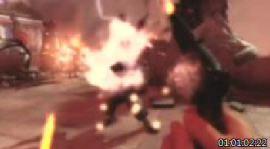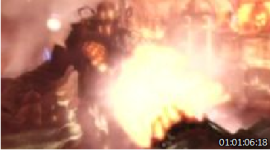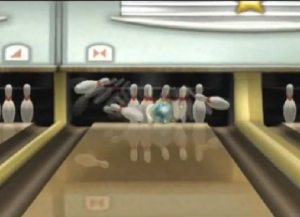Google’s Doodle Fruit Games: Seizure, anyone?
Posted: 08/07/2016 Filed under: Photosensitive Seizure Prevention, Results of safety testing, Seizure Risk, Seizure Warnings | Tags: 2012 Olympics logo, computer games, epilepsy, flash, flicker, Google, photosensitive epilepsy, seizure prevention, seizure warning, video games 1 Comment
Google’s landing page is featuring various doodles that celebrate the Rio Olympics and promote a fruit-themed games app. The doodles lead visitors to a promotional trailer about the app.
What do a pineapple playing tennis and a grape going for a ride have in common? Two things: 1) They’re currently appearing in Google’s Olympics-themed iOS and Android Doodle Fruit Games app, and 2) viewing them in Google’s video promoting the app could give you a seizure.
For the next two weeks while the game app is available, Google is promoting it with a zippy, fast-paced trailer. Visitors watching the trailer see rapidly moving images images that could provoke seizures in anyone with a condition known as photosensitive epilepsy. I tested the trailer for its risk of inducing seizures and found two segments–involving the aforementioned pineapple and grape–with a flashing effect that could trigger photosensitive seizures. From what I can tell, the problem images appear only in the trailer and not in the games app itself–unless they appear only after players achieve a high score that I didn’t reach.

Google’s promotional trailer at g.co/fruit contains images that can trigger seizures in some viewers.

This image of a pineapple wielding a tennis racquet is from one of two segments in the trailer that could provoke a seizure.
What is photosensitive epilepsy?
Photosensitive epilepsy is more common than is generally known, and researchers agree it is probably underestimated. People with the condition have epileptic seizures triggered by lights or images that flash faster than three times per second.
It gained some notoriety after a Pokémon cartoon shown on Japanese TV in 1997 sent nearly 600 children to emergency rooms with seizure symptoms. The condition had already been extensively studied and researchers had drawn up guidelines for reducing the seizure risk from video images, but at the time Japan did not protect TV viewers from problem images.
Who is affected by photosensitive epilepsy?
The vast majority of those with “regular” epilepsy are not affected by visual stimuli. But photosensitive epilepsy may be harder to detect and is underrecognized by the public and by doctors. You may be susceptible to photosensitive seizures and not even realize it since:
- Photosensitive epilepsy typically doesn’t develop until adolescence.
- It can occur in people with no history of seizures. Of Japanese children affected by the Pokémon cartoon, 76 percent had never before experienced a seizure.
- People with other forms of epilepsy are routinely tested for photosensitive epilepsy, but the condition may be most common in individuals who don’t have any other type of seizures. These people are very unlikely to be screened for it.
You can already be experiencing seizures and not know it.
- Not all seizures involve complete loss of consciousness, falling, or body movement observable by others. Such major events, known as generalized seizures, occurred in less than half of the Pokémon-affected children.
- Because consciousness is altered at the time, a person having a seizure often has no memory of it.
Even if you have no visible symptoms of a seizure, there can be lingering after-effects that include fatigue, sleep, learning, and memory problems, mood irregularities, among others.
How the media and entertainment industry can reduce seizure risk
More than 20 years ago, researchers studying photosensitive epilepsy defined the factors, in particular the flash frequency, that are most likely to provoke visually induced seizures.The UK has required all TV content to conform to seizure-reduction guidelines since 1994, and Japan enacted similar regulations following the Pokémon incident. To date, no other countries have done this, but a United Nations-affiliated agency did adopt recommendations for reducing photosensitive seizure provocation from television. Meanwhile, of course, interactive media have become a much bigger part of our lives than television, and the same guidelines for reducing seizures from TV should be adapted to the internet.

Seizures from a Pokémon cartoon shown in Japan drew attention to photosensitive epilepsy in 1997.
The World Wide Web Consortium (WC3), the international group that produces website accessibility standards for all types of applications, now includes guidelines for reducing the risk of visually triggered seizures. But incorporating such standards into private industry applications and sites is a hugely complex and time-consuming process.
The United States Department of Justice has been considering since 2010 the complexities of creating regulations ensuring access by the disabled to public and private websites. The DOJ announced this spring that rules governing private websites have been delayed until 2018 at the earliest.
In 19901, after a few consumer lawsuits were filed due to seizures, game developers began including a seizure warning that has kept consumers from filing or winning such lawsuits. Although most game documentation and packaging contain a seizure warning, not all games contain seizure-provoking visuals. Consumers don’t know which games actually have potentially harmful sequences and largely ignore the warnings.
How you can prevent photosensitive seizures
If you’re susceptible, even a brief exposure of a few seconds to flashing can be enough to bring on a seizure. If you know that you are vulnerable to these seizures, there are some precautions doctors recommend to avoid being triggered:
- When possible, avoid situations and stimuli that are likely to be provocative, including emergency lights, electronic billboards, video games, light shows, flickering fluorescent lights, fireworks, animé and other fast-moving cartoons
- Wear blue-colored glasses, which filter out the most provocative light frequencies. Most opticians can make these inexpensively.
- In the presence of flashing light, cover one eye.
- Increase your distance if possible from the flashing image–so, for example, stay at least 6 feet from your TV screen, and don’t play video games up close.
- Don’t play when fatigued or sleep-deprived.
- Take frequent breaks during prolonged exposure–although this won’t always help if you are triggered in a matter of seconds.
Testing for visuals that can provoke seizures
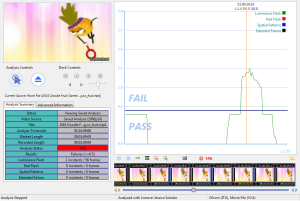
The results of testing the Google trailer with an image analysis tool are shown in this screen grab. Oscillating vertical stripes in the cartoon image in the upper left of the screen create a flashing effect that fail to meet guidelines for reducing the risk of photosensitive seizures.
I tested the trailer using an industry-standard application called the Harding Flash and Pattern Analyzer that detects image sequences that can trigger photosensitive seizures. It is based on algorithms devised by Graham Harding, one of the world’s leading experts on photosensitive epilepsy. The application is widely used by producers and networks in the UK—including by the BBC—to reduce the risk of seizures from material on broadcast TV. The analyzer examines video sequences frame by frame for very specific and measurable image qualities that researchers have found can trigger seizures.
Seizures from video shown on TV about 2012 Olympics logo

A video introducing the 2012 London Olympics logo was withdrawn in the UK after some viewers reported seizures.
This is not the first time that Olympics-themed promotional visuals have placed viewers at risk of seizures. A promotional video for the logo of 2012 London Olympics logo shown on British TV news in 2007 resulted in seizures in some viewers. It had not undergone the required testing that would have alerted producers to the problem prior to broadcast.
David Lynch music video: 70 violations of guidelines for reducing seizures
Posted: 07/05/2013 Filed under: Music Videos, Photosensitive Seizure Prevention, Results of safety testing | Tags: David Lynch, flash, flicker, Kanye West, music videos, photosensitive epilepsy, photosensitivity, seizure warning, Twilight: Breaking Dawn 4 Comments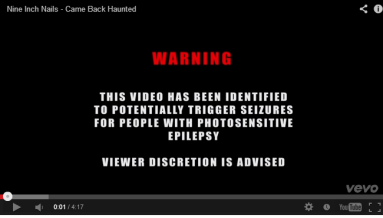
This warning is shown briefly before the video begins showing an onslaught of flashing images. This is just a screen shot, not the video itself.
David Lynch’s just-released music video for Nine Inch Nails’ “Came Back Haunted” provides more than 4 minutes of nearly constant seizure-provoking flashes and images. When analyzed for seizure safety, the video fails in 70 instances to adhere to international safety guidelines for flash, including the intermittent use of saturated red images.
Before the barrage of flashes begins, the official release on the Vevo music video website is accompanied by the following message: “WARNING: This video has been identified by Epilepsy Action to potentially trigger seizures for people with photosensitive epilepsy. Viewer discretion is advised.”
Two very big problems with this:
1. There’s a disturbing, no doubt intentional, consequence of highlighting the risk of seizures. Emphasizing that viewers are flirting with danger seems to be a marketing move. Unfortunately, this tactic does attract attention, but it trivializes the actual health risks.
2. Contrary to the claim that the UK Epilepsy Action organization determined that there was a photosensitive seizure risk in the video, Epilepsy Action’s website states that the organization was not consulted about the video. The organization is investigating and plans to continue reporting on it. A news item on the website quite correctly states, “It appears conscientious to show a warning before the video. However, many people with photosensitive epilepsy do not know they have it until something like this triggers their first seizure.” If filmmaker Lynch is conscientious, why not remove the seizure risk in the first place?
Trivializing seizures by using them for marketing
Here’s what happens when the seizure risk is used for marketing purposes. People who know nothing about epilepsy are charmed by the video’s association with seizures and use it to spice up their commentary:
- “David Lynch and Trent Reznor Make Seizure-Inducing Magic Together“ from Grantland.com
- “The New Nine Inch Nails Video Might Determine If You Have Epilepsy“ from Tucson Weekly
“…before getting into the fact it comes with a STERN WARNING THAT IT HAS BEEN KNOWN TO CAUSE SEIZURES one must take into account it was directed by David Lynch, the man responsible for Twin Peaks, Eraserhead and Blue Velvet…. I know you’ll all click on the video below to see if I’m just being outlandish and overreactive (what I like to call Glenn-Beck-ish), but remember, you were warned. Also, if you’re rendered comatose (or worse), I call dibs on your watch.”
- “Nine Inch Nails Release ‘Came Back Haunted’ Video, David Lynch’s Epileptic Nightmare“ from website of Los Angeles radio station KROQ-FM
“Came Back Haunted” packs in a myriad of flashing, distorted clips interspersed with Renzor singing as the camera captures the footage in a near-epileptic state of jitter.”
I found one reasoned commentary. Instead of swallowing the seizures-as-marketing bait, Rachel at bangs.com, to her credit, sees through it:
“…who wants to just hang out and watch a dumb boring music video anyway? I want a bit of DANGER in my viewing experience!”
Safely see for yourself how seizure-inducing it is!
I recorded what happened when I tested “Came Back Haunted” with the program I use to test images for seizure safety, the Harding Flash and Pattern Analyzer. If you view the testing session, you can see what it looks like when a clip is chock full of violations of seizure safety guidelines. When viewing the clip below of the Harding Flash and Pattern Analyzer test session, seizures are very unlikely unless you stare at the upper left-hand corner of the screen at very, very close range. (Smaller images affect a smaller area of the brain’s visual cortex, making it harder to generate the requisite number of neurons misfiring to get a seizure going.)
In this clip the video itself runs at twice its normal speed in the upper left corner of the screen. The rest of the screen shows the analyzer’s findings, in a large line graph and a table that tracks the number of frames that fail the safety test. This is not a borderline case!
Note: If you’re curious to see the offending video on YouTube in its official form, do keep in mind that since the flashing is downright nasty, the smaller you make the image on your screen, the less danger there is of triggering a seizure.
About Epilepsy Action’s role
Apart from the unauthorized and false statement that Epilepsy Action was consulted, there’s yet another problem with the claim. David Lynch is an American filmmaker, Nine Inch Nails is an American band, and the epilepsy warning refers to a British epilepsy advocacy organization that is vigilant and outspoken in monitoring photosensitive seizure triggers in popular media. Epilepsy Action has drawn the public’s attention to photosensitive seizure-provoking material in visuals broadcast on UK TV, in music videos (Kanye West) and in movies (Twilight: Breaking Dawn).
The American epilepsy advocacy community should be much more proactive and visible to the public, explaining the dangers of seizure-provoking media–including the fact that many people without “regular” epilepsy who have just photosensitive epilepsy are unaware they have the condition. If the epilepsy organizations are concerned about stigma–and they are–they need to advocate against seizure-provoking media and against demeaning portrayals of seizures that stem from photosensitivity. A whole generation of young people is forming opinions about seizures and epilepsy by reading the relentlessly insensitive stuff like David Lynch and Nine Inch Nails making “seizure-inducing magic together.”
Hat tip to John Ledford for making me aware of the video!
Open letter to the BioShock creative team
Posted: 04/18/2013 Filed under: Photosensitive Seizure Prevention, Results of safety testing, Seizure Warnings, Video Game Companies | Tags: BioShock, computer games, flash, flicker, photosensitive epilepsy, seizure warning, seizures, video games Leave a comment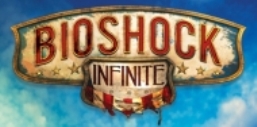 Congratulations on last month’s successful launch of BioShock Infinite. The reviews are extraordinary. BioShock Infinite is said to set a new standard for what the video game experience can be. Players are moved and enthusiastic about many aspects of the game and speak effusively about their unprecedented degree of involvement with the story and characters. With all the creative energy, care, and respect for players that went into developing BioShock, though, the game–like so many others–exposes players to visuals that can cause seizures.
Congratulations on last month’s successful launch of BioShock Infinite. The reviews are extraordinary. BioShock Infinite is said to set a new standard for what the video game experience can be. Players are moved and enthusiastic about many aspects of the game and speak effusively about their unprecedented degree of involvement with the story and characters. With all the creative energy, care, and respect for players that went into developing BioShock, though, the game–like so many others–exposes players to visuals that can cause seizures.
I examined several BioShock launch trailers and some other “footage” – a total of eight clips of a few minutes each – and assessed them using an application that identifies video sequences that can trigger seizures. Most of the material was fine, but three of the clips contained brief flashing sequences that don’t meet criteria for safe viewing. It doesn’t take more than a brief exposure to trigger seizures in those who are vulnerable.
Contrary to what many gamers assume, eliminating seizure triggers doesn’t make a game boring to look at or play. Irrational Software created a visually stunning, highly engaging experience in which most of the scenes don’t pose a seizure risk. Reports of video game-induced seizures began surfacing in 1981 in newspapers and medical journals. A great deal is known about what types of images and sequences can provoke seizures.
Guidelines for seizure-free video sequences were developed in the UK more than 20 years ago. Since 1991 all television programming and commercials there are required to pass a seizure-safety test. Japan put in place a similar measure following the 1997 Pokémon broadcast that led to hundreds of seizures. In 2005 the International Telecommunication Union published recommended universal guidelines for reducing photosensitive seizures from televised material.
While all these efforts were made to reduce the risk to consumers of photosensitive seizures, video game publishers took their own action—providing printed seizure warnings. The warnings began appearing in the early ‘90s, after a few consumers filed personal injury lawsuits. Putting a seizure warning on video games has thus far provided legal cover for your industry, but offers little protection for customers.
The warnings all state that photosensitive seizures happen to “a very small percentage of people.” Seizures from flashing images are not rare, but people believe they are because that’s what the warnings say! The wording of these warnings is based on researchers’ estimates that were made decades ago, before today’s sophisticated graphics and before more recent studies that suggest that many photosensitive seizures could be going completely unnoticed. Many doctors continue to think these seizures are rare because that’s what they were taught.
If you haven’t heard many reports of seizures happening while playing BioShock, don’t assume the seizures aren’t occurring. They’re just not being identified. A person experiencing seizures is likely to lose awareness and not even realize what’s happening, or notice that a bit of time has passed that they can’t account for. Furthermore, most seizures don’t involve convulsions, and the only sign others might see could be as subtle as a short period of staring.
Whether or not a seizure is noticeable, it’s a serious event with real risks to health. It can impair health, thinking, and behavior for days afterward. Sometimes a seizure results in permanent disability.
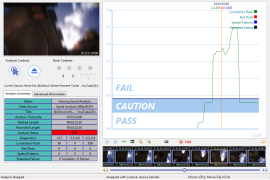
But this screen capture from the Harding Flash and Pattern Analyzer shows that flash in the BioShock sequence shown at upper left failed seizure safety guidelines.
It’s not reasonable to expect parents to continually monitor their kids for possible signs of a seizure, particularly given that video games are played while people face a screen. So let’s turn to older teens and adults in the midst of a game, who might theoretically be more self-aware and responsible for their own well-being. Will they be vigilant for seizure symptoms such as odd sensations or altered consciousness?
Just last month in a New York Times interview your creative director Ken Levine said, “We work really hard to wear down the audience’s ability to even process. If players are immersed enough, they stop treating it as a piece of artifice and just start experiencing it.” Do you see the problem here? In this ideal game experience, how can players be expected to “immediately stop playing and consult a doctor” as the warning advises, if they develop symptoms consistent with a seizure?
With BioShock Infinite now brought to market, people are asking what your company will do next. You could easily raise the bar further for the industry by publicly committing to developing seizure-safe games. I live in the Boston area and would welcome the chance to begin a conversation about this at your headquarters in Quincy.
Lawsuits filed after games caused seizures
Posted: 04/06/2013 Filed under: Legal Action, Seizure Warnings, Video Game Companies | Tags: American Academy of Pediatrics, computer games, Nintendo, photosensitive epilepsy, photosensitivity, product liability, seizure warning, Sony, Ubisoft, video games 3 Comments No consumer has won a product liability/personal injury case against a game manufacturer whose video game triggered seizures. Cases were either dismissed, settled, or won by the game company.
No consumer has won a product liability/personal injury case against a game manufacturer whose video game triggered seizures. Cases were either dismissed, settled, or won by the game company.
Despite their limited usefulness to consumers, seizure warning notices do seem to provide legal protection to game publishers. And juries have a hard time awarding damages to plaintiffs with a pre-existing condition, even if plaintiffs didn’t know of their photosensitive epilepsy prior to the seizure(s) triggered by a video game.
In one case Nintendo actually conceded that its game had in fact triggered seizures, but that didn’t get in the way of the company winning the case. A judge later overturned the jury’s verdict because Nintendo had withheld critical information in contempt of court.
The cases date back to 1991, but the apparent total number of cases–ten–is pretty small. One has to wonder what percentage of the seizures triggered by exposure to video games are ever identified as visually induced seizures.
One of the few consumers to reach a settlement is John Ledford of Alabama, whose settlement agreement bars John from discussing his own case. John has found another way to raise awareness of video game seizures. He has researched other cases and reached out to epilepsy organizations around the globe to raise their awareness of the continuing seizure hazard from video game images. John’s Facebook page contains most of the history I’ve assembled here:
| Year Filed | State | Plaintiff(s) | Game(s)/Platform/Defendant | Outcome |
| 1991 | MI | 15-year old Laura Moceri had grand mal seizure while playing. | Kid Icarus (Nintendo) | Lost |
| 1993 | IL | Chicago boy suffered occasional seizures during many hours of game play. | Nintendo | Dismissed |
| 1995 | AL | John Ledford had his first ever grand mal seizure while playing game at an arcade. The seizure damaged his optic nerve and caused blindness in one eye. | King of the Monsters II (SNK Corp.) | Settled |
| 1998 | LA | 13 year-old Joey Roccaforte had clusters of violent seizures | Mega Man X (Super Nintendo) | Jury ruled for Nintendo; judge later vacated the decision because Nintendo withheld critical information before and during trial. |
| 2001 | LA | Esther Walker, mother of 30-year old Benjamin Walker, who died from hitting his head on a table and sustaining internal injuries during a game-induced seizure. | Nintendo 64 | Lost |
| 2001 | LA | 11 year-old Michael Martin, son of Eric Martin, mayor of St. Martinsville, LA. Seizures that began happening during games began occurring also during sleep. | Super Mario Kart (Nintendo 64) | Settled personal injury claim; lost case advocating better warnings. |
| 2001 | LA | 6 year –old Kynan Hebert, son of Lynette Benoit | Nintendo | Dismissed |
| 2002 | FL | 16 year-old Dominic Zummo | Star Wars Episode I: Jedi Power Battles (LucasArts Entertainment, SONY) | Unknown |
| 2007 | NY | While watching his brother play a game, 4 year-old boy had a seizure causing permanent injury. | Spyro: Enter the Dragonfly (Vivendi, SONY Playstation 2) | Last available information: attorney for plaintiff was seeking other plaintiffs for class action suit |
| 2011 | CA | Navy F-18 pilot John Ryan McLaughlin injured in a grand mal seizure that causes permanent loss of flight status | Oblivion: The Elder Scrolls IV (Bethesda Software), Sony Playstation 3. | Still pending; no other information available. |
What constitutes product liability?
In 1997 the criteria for product manufacturer’s liability for a product that has caused harm were revised by the American Law Institute, an independent body of legal experts that drafts and publishes restatements of common law in order to clarify and simplify it. Its work is used as a resource by state lawmakers, judges, and lawyers. Every state has its own laws concerning burden of proof, the awarding of damages, and the like.
The 1997 restatement of product liability law states, “a product is defective when, at the time of sale or distribution, it contains a manufacturing defect, is defective in design or is defective because of inadequate instructions or warnings.” These conditions are then defined separately:
- A product “contains a manufacturing defect when the product departs from its intended design even though all possible care was exercised in the preparation and marketing of the product.”
- A product “contains a design defect when the foreseeable risks of harm posed by the product could have been reduced or avoided by the adoption of a reasonable alternative design by the seller or other distributor, or a predecessor in the commercial chain of distribution, and the omission of the reasonable alternative design renders the product not reasonably safe.”
- A product “is defective because of inadequate instructions or warnings when the foreseeable risks of harm posed by the product could have been reduced or avoided by the provision of reasonable instructions or warnings by the seller or other distributor, or a predecessor in the commercial chain of distribution and the omission of the instructions or warnings renders the product not reasonably safe.”
Some game companies are apparently working to make games that do not provoke seizures, but only Ubisoft has made a public commitment. As far as I can tell, most are merely reworking their warnings.
Kanye West loves strobe lights
Posted: 05/07/2012 Filed under: Health Consequences, Music Videos, Photosensitive Seizure Prevention, Political Action & Advocacy, Results of safety testing, Seizure Warnings | Tags: epilepsy, epilepsy advocacy, flash, flicker, Kanye West, music videos, photosensitive epilepsy, photosensitivity, seizure warning, seizures Leave a comment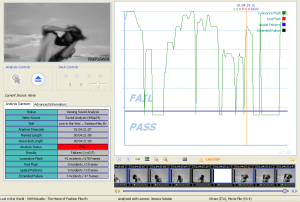
The Harding Flash and Pattern Analyzer shows flash levels in “Lost in the World” fail seizure safety guidelines by a wide margin. At upper left is a screen grab from the new video.
“Kanye West loves strobe lights,” cooed the Huffington Post the other day, reporting the release of the performer’s most recent flash-filled music video. “…the Chicago rapper…seemingly earns an epilepsy warning with every new project. His new video for the not-so-new song ‘Lost in the World’ certainly doesn’t deviate from the pattern.”
Apparently he loves strobe lights so much that–despite being informed, two music video releases ago–that his flashing visuals provoke seizures in some viewers, he is determined to use these effects anyway. Wow, you have to really respect a man who refuses to let the health of the viewing public get in the way of his artistic freedom. The Huff Post article continues in the same admiring tone: “…the rapper is known for his emphasis on quality videos (his half-hour ‘Runaway’ short film was perhaps the biggest statement of the rapper’s visual aesthetic).”
The rapper’s acknowledgement of a potential seizure problem has followed a strange path. In February 2011, accounts of seizures triggered by West’s “All of the Lights” video spurred UK-based Epilepsy Action to request that the video be removed from YouTube. In response, the video was temporarily removed and a warning was placed at the beginning:
This video has been identified by Epilepsy Action to potentially trigger seizures for people with photosensitive epilepsy. Viewer discretion is advised.
A year later the “N—-s in Paris” video was released with this same warning, although Epilepsy Action was never contacted about it.
And now there’s a warning at the beginning of the “Lost in the World” video that doesn’t even explain why the warning is important for viewers. All it says is:
Warning: Strobe effects are used in this video.
I expect Epilepsy Action will probably make a statement regarding the risks of viewing this latest release, and perhaps take issue with the less-than-explicit warning that was provided. How about some advocacy in the US? It’s time to confront the very preventable public health problem created by strobe effects in entertainment media.
A cynical Kanye West seizure warning
Posted: 02/14/2012 Filed under: Music Videos, Seizure Warnings | Tags: Kanye West, music videos, photosensitive epilepsy, photosensitivity, seizure warning, seizures 1 Comment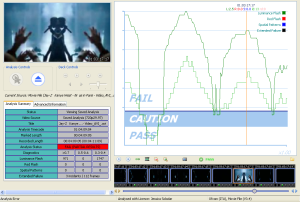
The video repeatedly exceeds seizure safety guidelines. Top left shows a screen grab. Graph shows multiple flash safety violations detected by the Harding Flash & Pattern Analyzer
Do Jay Z and Kanye West deserve kudos for placing a seizure warning at the start of their highly anticipated, flash-filled music video “N**gas in Paris”? Does a warning make it OK to produce videos known to place people at risk for seizures?
“Paris” is by far the most seizure-provoking piece of video I’ve ever tested with the Harding Flash and Pattern Analyzer. After just a few seconds it had already exceeded photosensitive seizure safety guidelines, and multiple violations continued throughout.
Because it contains a seizure warning, which was posted before anyone could complain about the seizure effects, somebody decided these guys have become considerate of those with photosensitive epilepsy. The entertainment press would like you to believe that West, who directed the video, is now sensitive to the issue of seizure-inducing images and may even have saved lives by placing a warning before the new Paris video. What a public relations coup!
“…a simple warning that Jay Z and Kanye West included at the top of their “N**gas in Paris” video may have been the difference between life and death for some of their seizure-prone fans …this according to multiple epilepsy organizations. The concern is obvious … since the video is filled with strobe lights and quick edits,” fawns TMZ.
A story headline at complex.com based on the TMZ piece reads, “CURE & Epilepsy Therapy Project Applaud Kanye West & Jay-Z for Warning in ‘Paris’ Video.” The reporter got statements from both of these highly respected US epilepsy advocacy organizations, praising the artists’ sensitivity to the epilepsy community.
Last year, when the UK’s Epilepsy Action objected to West’s very flashy “All of the Lights,” the video was temporarily removed from the Internet and subsequently reinstated with a seizure warning at the beginnning. The warning credited Epilepsy Action for determining that the video posed a seizure risk. This time around, however, without even consulting Epilepsy Action (!), the same warning was placed at the beginning of the Paris video. According to TMZ this means, “Lesson learned,” and “’Ye and Jay save the day!” Epilepsy Action, however, pointed out that while it may be good to have a warning, it would be far better if the material did not place viewers at risk of possible seizures.
Epilepsy Action notes in a statement that, “despite the concerns raised last year about the All of the Lights video, Kanye West has knowingly made another video which could be harmful to some fans watching it. We would like to see the music industry show much more responsibility by not commissioning videos that contain potentially dangerous imagery.”
The statement continues with a reminder that photosensitive seizures, especially in young people, frequently occur in individuals who don’t even know they are photosensitive. Seizure warnings are therefore totally inadequate because people incorrectly assume that if they’ve never had a visually induced seizure, they aren’t at risk. In the UK, regulations for broadcast television already require that video sequences fall within seizure safety guidelines, and Epilepsy Action is now calling for those regulations to be extended to the Internet.
Hats off once again to Epilepsy Action, and to the awareness and proactive public safety measures taken by UK communications regulators. Is anyone listening in the US and elsewhere???
2011: Inching toward fewer seizures from flashing electronic media
Posted: 01/06/2012 Filed under: Media Coverage, Medical Research, Movies, Music Videos, Photosensitive Seizure Prevention, Political Action & Advocacy, Seizure Warnings, Video Game Companies | Tags: epilepsy advocacy, flash, flicker, Kanye West, photosensitive epilepsy, photosensitivity, seizure prevention, seizure warning, Ubisoft, video games Leave a comment A huge amount of work is needed to protect consumers from the seizures triggered by flicker and flash from screens of everyday electronic media. But in 2011 there were some notable milestones in public awareness and prevention of photosensitive seizures. In no particular order, these are the year’s top five developments:
A huge amount of work is needed to protect consumers from the seizures triggered by flicker and flash from screens of everyday electronic media. But in 2011 there were some notable milestones in public awareness and prevention of photosensitive seizures. In no particular order, these are the year’s top five developments:
- A scene in the film Twilight Saga: Breaking Dawn triggered seizures in some audience members, most of whom had never experienced seizures before. Publicity about the seizures led to warnings by the UK’s Epilepsy Action and the Epilepsy Foundation of America. The film’s distributors provided a warning that cinemas could opt to provide to audiences. Although seizures triggered by movies shown in theaters aren’t common, this story brought wider attention to the risk of seizures from visual entertainment stimuli.
- Multinational game developer and distributor Ubisoft released a developers guide for creating video games that will not provoke visually induced seizures. Presumably it translates international guidelines for visual seizure safety into specific protocols for programmers. However, the guide is available only to member companies of TIGA, theUK’s trade association for video game developers and publishers.
- After the UK’s Epilepsy Action notified YouTube that an extended flashing segment in Kanye West’s music video “All of the Lights” could trigger seizures, a seizure warning was placed at the beginning of the video. It would be far better to fix than to keep the problem segments as is, even with a warning. Nobody pays attention to warnings, especially those who so far haven’t had a photosensitive seizure.
- Results of the first study to examine the rate of photosensitivity in young people on the autism spectrum were announced. They showed this population is at significantly increased risk of visually induced seizures. In young people 15 and older on the autism spectrum the photosensitivity rate is 25 percent. More studies are urgently needed, but with results as significant as these, more research will certainly be funded. While the study authors were focused more on commonalities in the roots of epilepsy and autism than on environmentally induced seizures in everyday life, the findings provide data that can be put to use immediately. The authors caution that it was too small a study (approximately 200 subjects) to merit placing limits on screen time. Nonetheless, parents of young people with autism spectrum disorders might want to be especially watchful of their children’s exposure to flashing electronic screens and any behaviors associated with screen time.
- Lenses that protect against visually induced seizures became readily commercially available. Zeiss F133 (previously known as Z1) cross-polarized, blue lenses can now be obtained from optician Antonio Bernabei, who ships worldwide from Rome. The lenses were developed by Zeiss with Italian photosensitivity researchers who demonstrated their effectiveness in clinical studies. In a study of people vulnerable to visually-induced seizures, while wearing the lenses 76 percent showed no abnormalities on EEG when tested with photic stimulation, and another 18 percent showed reduced EEG activation. Only 6 percent did not benefit at all. Until Bernabei began offering the lenses this past year, consumers and clinicians were unable to locate them without encountering a lot of dead ends.
These developments are more significant for the general public than most people realize because photosensitive seizures are not at all limited to individuals with epilepsy. Nobody knows for sure how many consumers experience visually induced seizures—including the small, unseen seizures that are never identified or reported. Three quarters of the affected people have no known history of seizures, no suspicion that they have this genetic vulnerability to flickering light, and therefore no prevention strategies. Onward to more progress in 2012!
“Twilight” cautions issued in US and UK
Posted: 12/05/2011 Filed under: Media Coverage, Movies, Political Action & Advocacy, Seizure Warnings | Tags: epilepsy advocacy, flash, flicker, photosensitive epilepsy, photosensitivity, seizure warning, seizures, Twilight: Breaking Dawn Leave a comment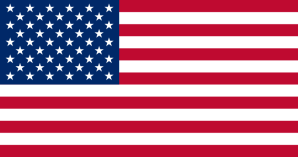 Epilepsy organizations in the US and UK have issued warnings about seizures during the birthing scene in the film Twilight: Breaking Dawn. Because of the warnings, the seizures have received additional press attention.
Epilepsy organizations in the US and UK have issued warnings about seizures during the birthing scene in the film Twilight: Breaking Dawn. Because of the warnings, the seizures have received additional press attention.
Unfortunately, the warning in the US did not address consumers outside the epilepsy community. It released a warning last week on its website, addressed only to people who know they have photosensitive epilepsy:
“If you have photosensitive seizures, please take this information into consideration when deciding whether to see this movie. Around 3 percent of the nearly 3 million Americans with epilepsy have photosensitive epilepsy.”
The Epilepsy Foundation missed a major opportunity to explain that those most at risk for visually triggered seizures are those who have a genetic vulnerability but haven’t yet experienced a seizure. So while the Epilepsy Foundation is to be commended for responding to early reports of seizures provoked by flashing light in the scene, it downplayed the extent of the seizure risk.
As of today, 15 individuals have provided information about their Twilight seizures to a website tracking them, and only three had experienced prior seizures. What about the remaining 12 people? Would they have avoided the movie on the basis of a warning aimed at people who know they photosensitive epilepsy?
Not surprisingly, media coverage relied on information provided in the Epilepsy Foundation’s statement. For example, the Baltimore Sun’s story, which was picked up by a number of other newspapers, stated,
“While epilepsy is relatively uncommon in the population — about 3 million Americans have it — photosensitivity is even rarer, occurring in just 3 percent of those with epilepsy.”
To its credit, the Epilepsy Foundation warning provided links to excellent information on its site about visually induced seizures. Next time the organization should point out that anyone might have these seizures, not only people with epilepsy. When balancing the desire to protect those with epilepsy from unnecessary restrictions on daily activities against the greater public’s need to know about visually induced seizures, the Foundation favors the sensitivity of its own membership.
 Over in the UK, in response to reports of seizures among American movie-goers, the advocacy group Epilepsy Action did indeed take action, even without reports of seizures in British viewers.
Over in the UK, in response to reports of seizures among American movie-goers, the advocacy group Epilepsy Action did indeed take action, even without reports of seizures in British viewers.
For its part, Epilepsy Action made clear in its own news release about the film that photosensitive seizures can also affect people with no prior connection to epilepsy.
“Many people with photosensitive epilepsy, especially young people, do not know they have it until something triggers their first seizure. In 1997, an episode of Pokemon shown on Japanese television caused almost 600 people to have seizures. Of these, 76 per cent had no previous history of epilepsy.”
According to Epilepsy Action’s news release, the group contacted Breaking Dawn’s UK distributor and requested confirmation that the birthing scene had been checked for photosensitivity. The distributor (which did not confirm the photosensitivity check) then issued a seizure warning that will be displayed for movie audiences.
Wii helps doctors locate seizures (!)
Posted: 10/21/2011 Filed under: Diagnostic Challenges, Media Coverage | Tags: computer games, EEG, epilepsy, Nintendo, seizure warning, seizures, video games, Wii Leave a commentA local health feature broadcast this week in South Bend, Indiana credits the Wii for helping doctors identify where in the brain children’s seizures occur. When patients are in the hospital for seizure monitoring, doctors want to capture actual seizures in order to gather potentially valuable EEG data. If seizures don’t occur with the monitoring equipment in place, it’s a missed opportunity to collect information doctors can use to guide seizure treatment.
To increase the chances that seizures can be captured during the EEG monitoring, now the kids play Wii games! Thanks to the Wii, seizures are more likely to happen when they can be most helpful to doctors. The Wii has allowed seizures to be recorded on EEG in at least 25 percent more patients, according to the story.
“The most important purpose is to get them tired. We know that if you’re very tired, you’re more prone to have seizures,” explains Dr. Angel Hernandez, the neurologist interviewed for the story. Although fatigue lowers the body’s seizure threshold, it’s not the fatigue itself that produces the seizure. No matter how tired you are, without the visual stimulation of the video game, you’re not very likely to have a seizure.
Of course, the elephant in the room here is that video games do commonly trigger seizures, whether or not doctors deliberately provoke them and whether or not they are even noticeable events. You don’t really need to tire out the kids with the physical activity of Wii games. Just get them seated with any brightly flashing game screens, and you can produce the same results. Unfortunately the health reporter for this story did not explore the problem that is the flip side of Wii as a seizure trigger. I have to wonder how pleased Nintendo’s public relations people are with this particular feature story.
Why we ignore seizure warnings: Some “light” reading
Posted: 08/24/2011 Filed under: Legal Action, Seizure Warnings | Tags: computer games, photosensitive epilepsy, photosensitivity, seizure warning, seizures, video games Leave a comment Aftter seeing so many useless disclaimers, it’s no wonder people skip over the seizure warnings that come with video games. We’d rather start using our new purchase instead of reading through safety precautions that presume we have no common sense.
Aftter seeing so many useless disclaimers, it’s no wonder people skip over the seizure warnings that come with video games. We’d rather start using our new purchase instead of reading through safety precautions that presume we have no common sense.
A few months ago I gave an example of a ridiculous-sounding product warning to illustrate why it is that most folks routinely skip over the safety advisories in product manuals. I started searching for other examples of silly disclaimers in product literature that are placed to protect the manufacturer from liability claims. Here are a few:
- “ATTENTION: The cutting edges of scissors are sharp and care should be taken whenever cutting or handling.” — crayon manufacturer’s manual for arts and crafts projects
- “Although all possible measures have been taken to ensure the accuracy of the material presented, neither the author nor the publisher is liable in case of misinterpretation of directions, misapplication, or typographical error.” — book on growing your own vegetables, fruits and herbs
- “DO NOT run the vacuum over large-sized objects.” — vacuum cleaner owner’s manual
- ”Do not place fan in or near a window, to avoid contact with the outdoor elements.” — manual for a personal fan
Some enterprising people have already collected many examples of this disclaimer genre that make for amusing reading. Here are some links to silly warnings/disclaimers that will make you shake your head in wonderment. Note that I can’t vouch for the authenticity of the items on these lists nor guarantee that you will be amused (that’s a disclaimer).
http://www.mlaw.org/wwl/pastwinners.html
http://www.rinkworks.com/said/warnings.shtml
http://www.bored.com/crazywarnings/

